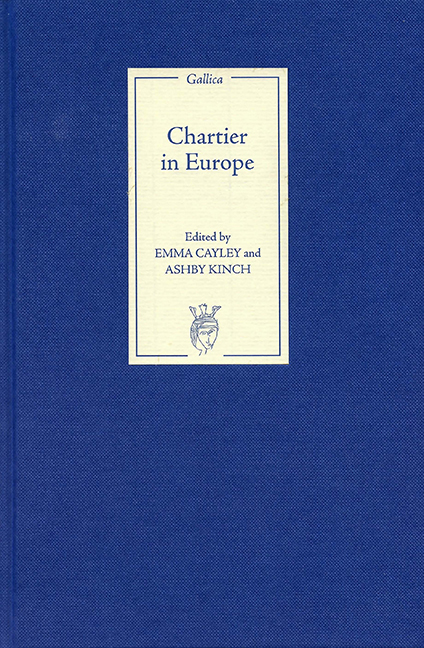Introduction
Published online by Cambridge University Press: 24 October 2017
Summary
Car son engin fu si haultain
Et son bon renon si certain,
Que s'il estoit encore en vie,
Je ne vys huy courage humain
Qui l'osast blasmer par envye.
Alain Chartier, known to the sixteenth century as the ‘pere de l'eloquence françoyse’ (and ranked alongside Dante in both English and French works for his contribution to vernacular eloquence), was one of the most provocative, significant and prolific authors of late medieval France, composing both poetry and prose in Latin and French. Chartier's works were celebrated, imitated, translated and transmitted widely throughout Europe during the fifteenth and early sixteenth centuries, and set up as models both in manuals of versification such as ‘L'Infortuné's’ Instructif de seconde rhétorique (1480), in the immensely popular manuscript anthology the Jardin de Plaisance, printed by Anthoine Vérard in 1501, Pierre Fabri's Le Grant et Vrai Art de pleine rhétorique (1521), or Thomas Sebillet's Art poëtique françois (1548), and in poetical works of the later period. However, as Laidlaw confirms in the Foreword to our volume, the relatively small number of modern studies on Chartier (compared with later medieval authors such as Christine de Pizan or François Villon), and the frequent emphasis on his prose as the ‘instrument of his greatest works’ (W. B. Kay), has tended to obscure his exemplary contemporary reputation until recent years. While scholars such as Champion, Poirion, Walravens and Hoffman have discussed Chartier's influence as part of their more general study of his writing, this volume aims to focus attention squarely on the question of the legacy and impact of Chartier's oeuvre, including his far-reaching influence on court poetry and debate, norms of eloquence and political thought.
Chartier's selected works appeared in no fewer than twenty-five printed editions from 1489 (Pierre le Caron) to 1617 (Samuel Thiboust), and they were collected in around two hundred fifteenth-century manuscript copies. The European appeal of our ‘clerc excellent, orateur magnifique’ is demonstrated by the number of translations of his works that were circulating in the late fifteenth century. There are fifteenth-century Middle French and English translations of Chartier's Latin works, the De vita curiali and the Dialogus familiaris (including an English translation by William Caxton of 1484). The French prose works were also translated into Castilian (Quadrilogue invectif) and Middle English (Quadrilogue, Livre de l'Esperance).
- Type
- Chapter
- Information
- Chartier in Europe , pp. 1 - 12Publisher: Boydell & BrewerPrint publication year: 2008

